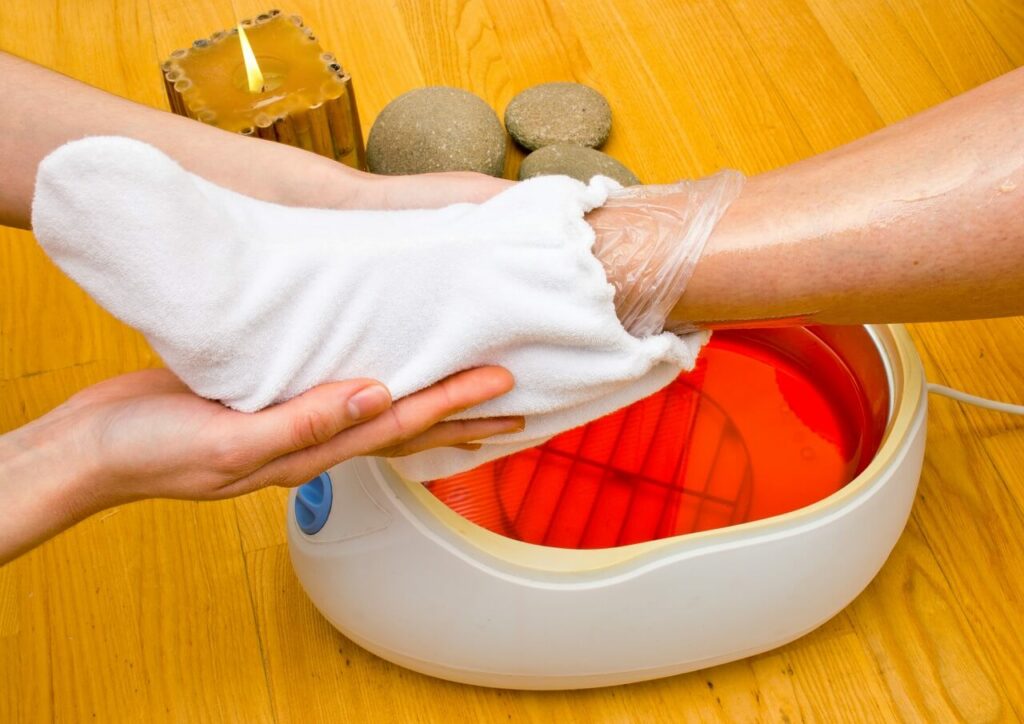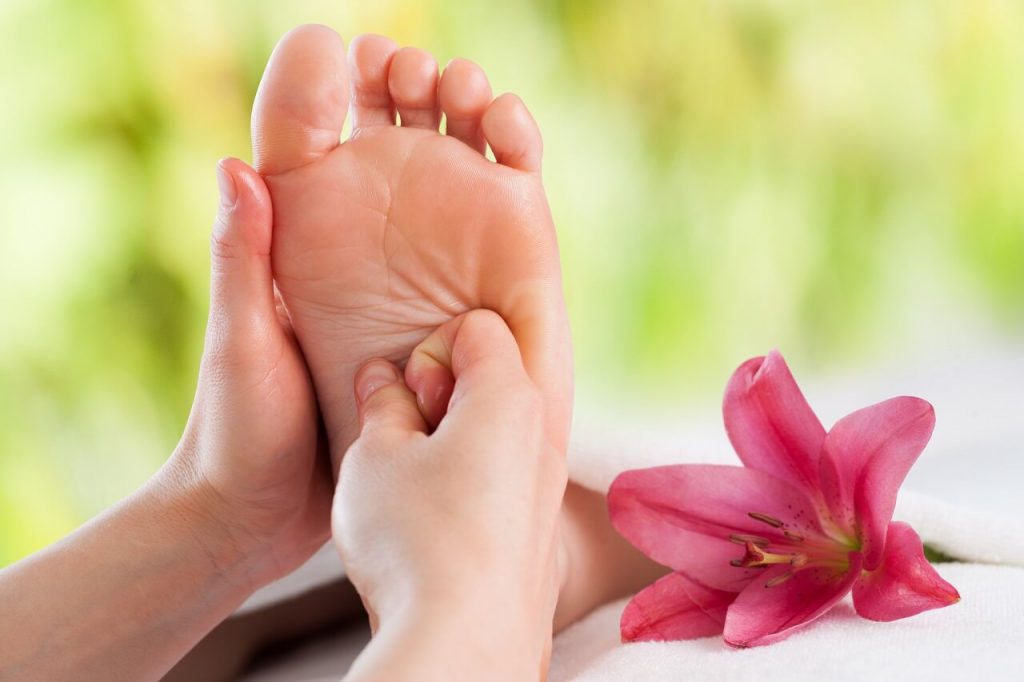A professional pedicure at a salon always starts with a foot spa. Your feet are soaked in warm scented water for a few minutes. This is followed by an exfoliation, massage, nail trimming and other treatments.
If you’ve ever wondered what nail salons use to soak feet, or even why they soak your feet, I have the answers. I also give you tips on how to do your own professional pedicure at home, complete with the relaxing foot soak.
Table of Contents
What Do Nail Salons Use To Soak Feet?

There’s no special foot soak that’s only available to salons. That foot spa that feels so relaxing contains mostly warm water.
But a few other things are added to the water. The most common is epsom salt, which softens your feet and readies them for exfoliation.
Some salons will also add a moisturizing oil to the water to keep your feet from getting dry. For scent, essential oils are also added.
Epsom salt and essential oils are generally safe for external use. But if you have sensitive skin, they can cause a reaction such as an itchy rash or redness. Ask the salonist if you can soak your feet in plain warm water without anything added.
Warm water on its own also does a great job softening and relaxing your feet.
Also be cautious if you have a wound or infection on your feet. While an epsom salt bath can speed up healing, it can also irritate the injured area.
If you experience any pain during the soak, let the salonist know and they can switch to plain water.
Why Do You Need To Soak Feet Before A Pedicure?
There are several important reasons why you get a foot bath before a pedicure.
- It softens your feet and prepares them for exfoliation. Exfoliating dry feet can be uncomfortable, even painful. The warm water and epsom salt soften your feet, especially calluses, making exfoliation easier, more effective and painless.
- It relaxes your feet. Think of it as a mini spa just for your feet. The combination of warm water, epsom salt and essential oils helps relieve sore or aching muscles.
- It cleanses your feet by removing dust, some dead skin cells and sweat.
- It softens your toenails, ensuring trimming is easy and comfortable.
How To Make Your Own Salon Foot Soak At Home
You can make a foot bath at home that’s just as good as the one you get at a nail salon.
All the ingredients they use at the salon are fairly easy to find. You can also substitute them with stuff already in your kitchen.
The first thing you’ll need is warm water. You can stop there if you want, especially if you don’t want to risk any reactions. As I mentioned, warm water is great for softening feet and easing any pain and soreness.
If you want a long soak (about 30 minutes) Keep adding hot water to the basin to keep the water from going cold.
Alternatively, buy a heated foot spa that keeps the water warm. These foot spas also come with additional features such as jets, bubbles, vibration and shiatsu massagers.
If you want to replicate the exact foot bath used at nail salons, add epsom salt to the warm water. A half cup of epsom salt in the basin is enough.
You can also add a few drops of your favorite essential oils to the bath to moisturize your feet and make the water smell nice.
Essential oils have other benefits as well. For instance, some essential oils like tea tree can help with problems such as athlete’s foot and other fungal infections, foot pain, foot odor and other foot-related problems.
And that’s it — warm water, epsom salt and essential oil. Soak your feet in this mix for 20-30 minutes. Dry your feet thoroughly afterwards. They should feel super soft.
If you want, this is the perfect time to exfoliate your feet. Take a bit of that epsom salt and rub it on your feet. You can also mix it with sugar and an oil like coconut or olive.
You can also use a pumice stone to exfoliate your feet.
Finish by applying a moisturizer on your feet.
If you don’t have epsom salt at home, there are several alternatives that work just as well at softening and exfoliating your feet. Here are three easy ones you can try.
Homemade Vinegar Foot Soak
Vinegar has the same softening effect as epsom salt. It also has antimicrobial and antibacterial properties, which can help with issues such as athlete’s foot, foot odor, and skin infections.
To make a vinegar foot bath, mix two parts hot water with one part vinegar. The vinegar will cool the hot water to a comfortably warm temperature.
Soak your feet for 20-30 minutes, then wipe your feet and moisturize them. Do not soak for longer than 30 minutes to avoid making your feet too dry.
You can use distilled white vinegar or apple cider vinegar.
Baking Soda Foot Soak
Baking soda is another great way to soften your feet and ready them for exfoliation. But be careful as it can cause irritation on sensitive skin.
Only use a little (about two tablespoons in a basin of warm water) or avoid it completely if you have highly sensitive skin.
Soak your feet for 20-30 minutes, then dry and exfoliate them with a pumice stone. Remember to apply a moisturizer when you are done.
Lemon Juice Foot Soak
Like vinegar, lemon juice is an acid. It softens dry and cracked feet, can help prevent or treat bacterial and fungal infections, and it helps remove dead skin cells.
To make a lemon juice foot soak, squeeze a couple of lemons into a basin of warm water. You can also throw in the lemon pieces. Alternatively, add two tablespoons of pure lemon juice to the water.
Soak your feet for 20-30 minutes, then exfoliate and moisturize them.
For added healing benefits, feel free to also add a squeeze of honey to the water.
Because lemon juice can be irritating, avoid this type of foot bath if you have any open wounds. It’s also not suitable for people with sensitive skin.
Benefits Of An Epsom Salt Foot Soak
While there are plenty of ways to soften feet before a pedicure, epsom salt is the most popular option used in salons.
That’s because it has plenty of benefits, beyond turning your feet baby soft.
- It is safe for most people. Unlike most other products like lemon juice, you can even use it if you have an open wound (as long as it’s not deep or draining).
- Epsom salt is an excellent exfoliator. Use it in a foot soak to soften skin and calluses, then follow up with an epsom salt + sugar + oil scrub to complete the exfoliation. If you have dry, rough and calloused feet, regular epsom salt soaks are one of the best treatments.
- Epsom salt is a popular treatment for various fungal infections.
- An epsom salt foot bath can also ease pain related to infections, inflammation, muscle soreness and other foot problems.
Is A Foot Soak Safe For Diabetics?

Diabetics should never use any kind of foot soak or bath without the advice of a doctor. Soaking your feet can make them drier, leading to cracks and infections.
So before you go to the nail salon, talk to your doctor first. Depending on your symptoms and the condition of your feet, they may recommend against getting an epsom salt foot bath at the salon.
They may recommend just using warm water to soak your feet.
When you go to the nail salon, make sure they know you have diabetes. Let the person attending to you know what they can and cannot do (e.g. no sharp instruments under the nails).
If your feet have wounds, infections, cuts or sores, it is best to skip the salon visit completely. It’s too risky. Instead, look for a podiatrist who specializes in diabetic foot care.
The same applies if you have neuropathy in your feet.
Can A Foot Bath Detox Your Body?
You may have heard that one of the benefits of a foot soak is that it draws toxins out of your body. In fact, there are some nail spas and salons that offer detoxing foot baths.
Unfortunately, that’s now how detoxing works. A foot bath doesn’t draw anything from your body. It only softens and relaxes your feet.
Here’s a great video debunking this common misconception.
Some people also claim that the magnesium in epsom salt gets absorbed into your body and has various health benefits. That’s not true either.
There’s no evidence that the body absorbs any meaningful amount of magnesium from an epsom bath. If you need magnesium supplementation, talk to your doctor about getting a proper supplement.




